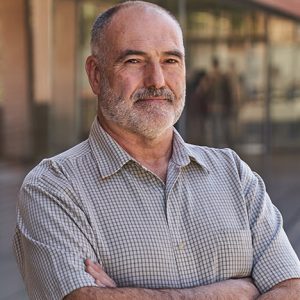Molecular Physiology Laboratory
Department of Biochemistry and Molecular Biomedicine
Faculty of Biology, UB
Antonio Felipe
ORCID ID: 0000-0002-7294-6431
Tel +34 934 034 616
https://www.ub.edu/portal/web/dp-bioquimica-biomedicina/mplab
• Antonio Felipe • Daniel Sastre • Irene Estadella • Silvia Cassinelli • María Navarro • Magalí Colomer • Carla Viñola • Anna Benavente

Current
Research
The Molecular Physiology laboratory is interested on the molecular identification and physiological role of Na+ and K+ ion channels in immune system cells, and its regulation in the cardiovascular and nervous system. Ionic channels are the membrane proteins responsible for the regulation of the action potential and maintaining the membrane potential by passing ions through the lipid structure of plasma membrane. Their activity is very important in synaptic transmission and in the electric waves in the brain. They also play a key role in the cardiac action potential. Whereas the physiological role of ion channels in tissues with electric properties is clear, their role in non-electrically cell types is uncertain. Thus, ion channels play roles in the insulin release by pancreas, salt reabsorption and cell volume control during renal filtering or acid secretion in gastric cells. In the immune system, controlling leukocyte physiology and being responsible for the immune response, are at the onset of many autoimmune diseases. Furthermore, these proteins participate during the cell cycle progression and are implicated with physiologic and neoplastic cell growth. Therefore, ion channels are considered good, effective and specific therapeutical targets for many human maladies, named as channelopathies. The channelosome is a complex oligomeric organization and the traffic and localization of the whole structure is crucial for the human homeostasis. We aim to decipher the protein interactions, the traffic and the localization within the assembled functional channelosome. The knowledge of the molecular determinants governing these events is crucial for understanding the role of these complex macrostructures, which are vital for the human health.

Selected
Publications
Capera, J.; Pérez-Verdaguer, M.; Peruzzo, R.; Navarro-Pérez, M.; Martínez-Pinna, J.; Alberola-Die, A.; Morales, A.; Leanza, L.; Szabó, I.; Felipe, A. A novel mitochondrial Kv1.3-caveolin axis controls cell survival and apoptosis. Elife. 10:e69099, 2021. doi.org/10.7554/eLife.69099
Oliveras, A.; Serrano-Novillo, C.; Moreno, C.; de la Cruz, A.; Valenzuela, C.; Soeller, C.; Comes, N.; Felipe, A. The unconventional biogenesis of Kv7.1-KCNE1 complexes. Science Advances. 6(14):eaay4472, 2020. doi.org/10.1126/sciadv.aay4472
Solé, L.; Roig, S. R.; Sastre, D.; Vallejo-Gracia, A.; Serrano-Albarrás, A.; Ferrer-Montiel, A.; Fernández-Ballester, G.; Tamkun, M. M.; Felipe, A. The calmodulin-binding tetraleucine motif of KCNE4 is responsible for association with Kv1.3. FASEB Journal. 33(7):8263-8279, 2019. doi.org/10.1096/fj.201801164RR
Pérez-Verdaguer, M.; Capera, J.; Ortego-Domínguez, M.; Bielanska, J.; Comes, N.; Montoro, R. J.; Camps, M.; Felipe, A. Caveolar targeting links Kv1.3 with the insulin-dependent adipocyte physiology. Cellular and Molecular Life Sciences. 75(21):4059-4075, 2018. doi.org/10.1007/s00018-018-2851-7
Martínez-Mármol, R.; Comes, N.; Styrczewska, K.; Pérez-Verdaguer, M.; Vicente, R.; Pujadas, L.; Soriano, E.; Sorkin, A.; Felipe, A. Unconventional EGF-induced ERK1/2-mediated Kv1.3 endocytosis. Cellular and Molecular Life Sciences. 73(7):1515-28, 2016. doi.org/10.1007/s00018-015-2082-0

